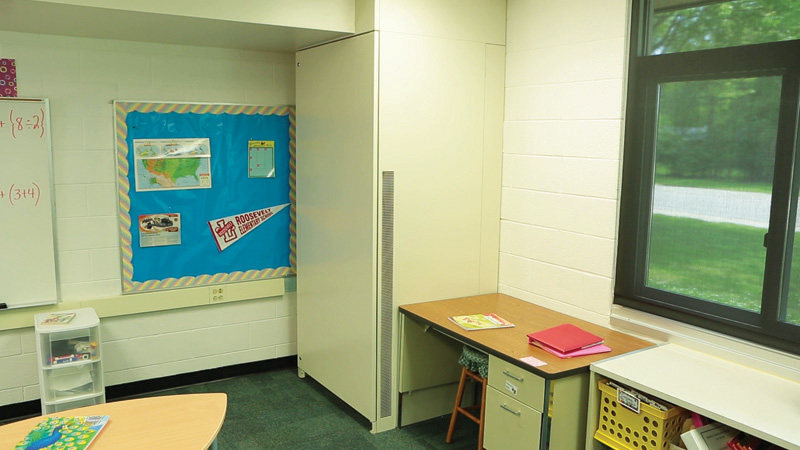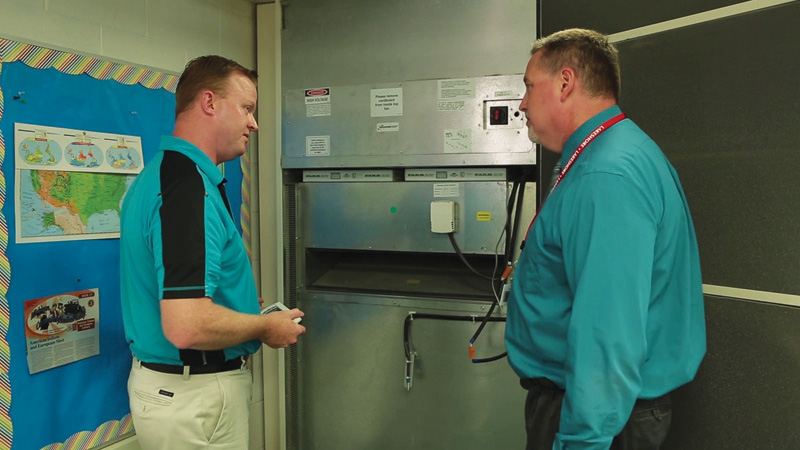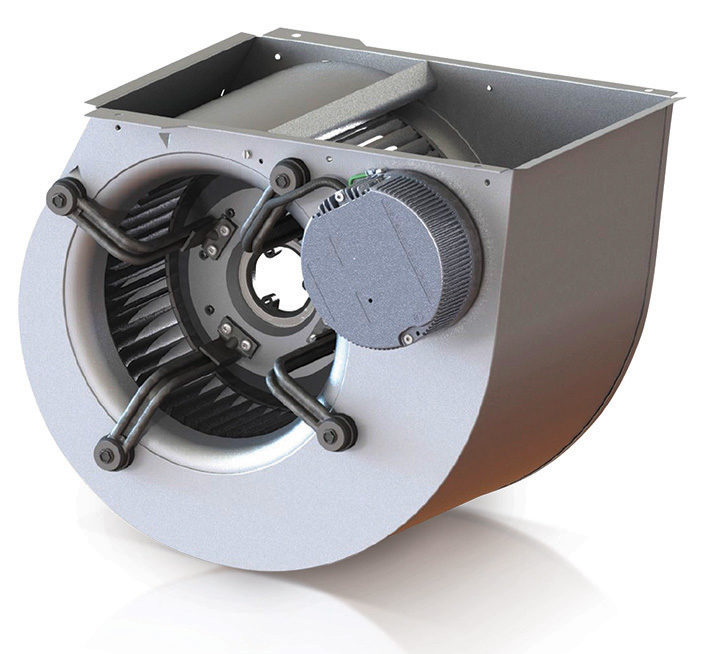Making the (up)grade with HVAC systems
by Katie Daniel | September 13, 2017 3:43 pm
 [1]
[1]by Paul Selking
As K−12 school budgets dwindle and energy costs rise, fewer resources are dedicated to school operations and maintenance. As a result, the health and performance[2] of these buildings (and the students and staff inside) suffer. With the cost to maintain and improve educational facilities increasing, schools need to invest in retrofits and ongoing maintenance to assert control over their utility costs.
According to the U.S. Environmental Protection Agency[3] (EPA), the nation’s 17,450 K−12 school districts spend more than $8 billion annually on energy—more than is spent on textbooks and computers combined. An estimated $2 billion of that total could be saved by improving energy efficiency in schools, equivalent to the cost of nearly 40 million new textbooks. Complicating these calculations is the aging of America’s public schools, which are, on average, 44 years old, according to the National Center for Education Statistics (NCES). The ‘functional age’ of public schools, when renovations are factored in, is 19 years.
The good news is energy is one of the few expenses that can be decreased without negatively affecting classroom instruction. Thousands of school boards have figured out ways to invest in energy efficiency and renewable energy improvements, demonstrating smart energy choices can have lasting benefits for their students, their communities, and the environment. Along with achieving significant energy cost savings, investing in energy efficiency can produce environmental, economic, and educational benefits.
Improving schools’ energy efficiency and outcomes
EPA has found increasing energy efficiency in K−12 school buildings can have the indirect benefit of bettering acoustic comfort, enabling effective communication by minimizing audible disturbance from outside and inside, and improving student performance. Additionally, the money saved from lower energy bills can help schools pay for building upgrades that enhance the health and quality of students’ learning environments—examples include skylights for daylighting, retrofitted shading devices, energy-efficient windows, and better insulation. School districts throughout the country are realizing energy improvements[4] have the potential to save the nation’s schools $1.5 billion each year and, at the same time, create better learning environments.
 [5]
[5]The physical condition of school facilities affects the performance, comfort, and stress levels of students and teachers alike. A wide body of research illuminates the relationships between the physical and human performance of schools, including the links between:
- indoor air quality (IAQ) and rates of absenteeism and asthma;
- lighting quality and student concentration;
- classroom acoustics and student attention;
- access to some form of physical activity and healthy cognitive development;
- design and condition of facilities and academic achievement; and
- quality of school buildings and long-term staff and teacher retention.
Schools achieving higher building energy ratings can have a positive impact on student test scores[6] as well. By installing more energy-efficient equipment, such as an upgraded HVAC system, school administrators are enhancing student comfort, health, and attention span, which can ultimately give education outcomes a lift.
The U.S. Government Accountability Office (GAO) estimates more than 15,000 schools nationwide report suffering from poor indoor air quality. Further, as mentioned, EPA says these schools experience increased absenteeism, decreased student concentration and productivity, and lower student test scores. Poor IAQ is also a known trigger of asthma—a condition that accounts for 14 million missed school days each year, according to the Asthma and Allergy Foundation of America (AAFA). (For more, see Rachel Belew’s article, “A Breath of Fresh Air,” in the September/October 2011 issue of Principal.)
Schools are also faced with the issue of IAQ standards that require fresh air to be introduced into classrooms at a substantial rate. The national consensus standard for outside air ventilation is American Society of Heating, Refrigerating, and Air-conditioning Engineers (ASHRAE) 62.1-2010, Ventilation for Acceptable Indoor Air Quality, and its published Addenda. This standard is often incorporated into state and local building codes and specifies the amounts of outside air that must be provided by natural or mechanical ventilation systems to various areas of the school, including classrooms, gymnasiums, kitchens, and other special use areas. High-quality HVAC systems must meet the stringent requirements of modern education environments.
 [7]
[7]Upgrading schools’ HVAC systems
According to GAO[8], “heating, ventilation, and air-conditioning systems were the most frequently reported building feature in need of [extensive] repair.” Since HVAC can account for as much as half of a school’s annual energy use, by retrofitting the equipment, schools can significantly reduce energy costs—sometimes by as much as 45 percent.
Research demonstrates the health and performance of students and staff corresponds directly with the performance of the HVAC system. (This comes from Lawrence Berkeley National Laboratory’s [LBNL’s] Indoor Air Quality Scientific Findings Research Bank.) A high-performing system not only limits the presence of airborne toxins and mold-causing dampness, but may also help maintain classrooms at temperatures optimal for comfort and focused learning. Given a typical HVAC system can consume upward of two-thirds of the energy used in a school, there are also opportunities to substantially reduce energy costs by improving the efficiency of the system’s components. (For more, see EPA’s Indoor Air Quality Design Tools for Schools: HVAC Systems. Visit www.epa.gov/iaq-schools/indoor-air-quality-design-tools-schools[9].)
Facility managers typically identify budgetary constraints, cost-cutting, and the up-front expense of building improvements as the greatest financial obstacles. By considering different finance mechanisms barriers, such as improvement financing (including up-front costs, cash flow considerations, and budgetary and regulatory constraints), school boards are able to implement the infrastructure upgrades.
For example, many schools are interested in using performance contracting to implement needed upgrades for their facilities and achieve energy savings. Others can take advantage of their local utility company’s standard incentives for installing new, energy-efficient equipment. Cash incentives may also be available to schools planning unique equipment installations and system and industrial process improvements.
Selecting the right HVAC system
The design and selection of the right HVAC system should combine a choice of engineered products efficiently providing conditioned air to the space at optimal energy while adding architectural features that complement the interior design. The internal environment[10] of the buildings must be a major focus point in the HVAC system selection. Efficiency, performance, cost, and energy use are considerations when choosing components. In K−12 classrooms, it is extremely important to minimize equipment and air distribution noise. It is critical to select low-decibel equipment and define its location relative to the conditioned space. To this end, many school district facility managers have come to realize the benefits of a single-packaged vertical unit that blends seamlessly into classrooms, providing students and teachers a healthier and quieter learning environment.
To improve on these systems, HVAC manufacturers are integrating an all-in-one blower motor system into their units. This combines a high-efficiency blower housing, axial flux, brushless alternating-current (BLAC) motor, and variable-speed electronically commutated motor (ECM) technology into a single assembly that delivers higher efficiencies, improved airflow, and lower maintenance costs. Additionally, this system puts out an average of 2 to 3 dB less than comparable systems, making it ideal for classrooms.
Proper ventilation with outdoor air is a key component for good IAQ in schools and classrooms. While there are many different HVAC system designs and operational approaches to achieving proper system functionality, every building is unique in its design and operation. Treatment can differ depending on:
- the geographical location of the building;
- ambient conditions;
- indoor requirements;
- building materials;
- dimensional parameters;
- aesthetic requirements;
- noise; and
- environment issues.
Classrooms generally have high ventilation requirements (i.e. potentially three times that of an office), but only when occupied. Dedicated classrooms, such as science and computer areas, require extra cooling or ventilation. Administrative areas require lower heating and cooling, but are occupied over longer hours. ASHRAE 62.1-1999 recommends each person in a classroom receive 15 cfm of fresh air, meaning a classroom with 30 people requires a ventilation rate of about 450 cfm.
Many different types of equipment and configurations are available to meet the requirements for schools. These configurations fall into two basic design categories: zoned comfort systems, which condition individual zones or one central system that conditions an entire school.
No matter what HVAC system is chosen for a school, the system will require computer controls (i.e. dedicated digital systems [DDS]) to monitor and adjust heating and ventilation rates. Systems can be designed for remote monitoring from the administrative office, or for individual classroom temperature control. Sophisticated systems are interoperable with a district’s entire building automation system (BAS). The key benefit of controls is their ability to reduce operating costs.
Zoned comfort systems
Zoned comfort systems—such as unit ventilators, water source heat pumps, and fan coils—provide heating, cooling, and conditioning (e.g. humidity control by unit ventilators) to individual classrooms or zones. The advantage of a zoned comfort system is one unit can provide cooling to one space while another unit is providing heating to a different space. The units can be controlled so their space is not cooled or heated when not occupied—this helps reduce operating costs.
Central systems
Unlike zoned comfort systems, which control individual zones, a central system controls several zones (e.g. a block of classrooms, the administrative area, or the gymnasium). These systems condition air in a remote location, such as a mechanical room or on a roof, and distribute it through ductwork to the occupied spaces. Central systems can include air-handling units (AHUs) and chiller plants, rooftop systems, and vertical self-contained systems.
HVAC in action: Lakeshore Public School District
Located in Stevensville, along Lake Michigan in the southwestern region of the state, the Lakeshore Public School District consists of three K−5 elementary buildings, one middle school, and one high school. Nick White, director of operations for Lakeshore public schools, has orchestrated many changes at the five facilities, including broad HVAC upgrades improving both student and teacher comfort, as well as energy efficiency.
In 2013, White and the Lakeshore school board looked at options to enhance student achievement. It had been about 20 years since any of the schools had new heating equipment installed, and none of them had any form of air-conditioning.
“We would get daily complaints from teachers about the inconsistency of room heating. Students seated by old, under-the-window unit ventilators were either sweating or shivering,” said White. “In the mornings, the ventilators would be blasting heat and later, as the thermostat was satisfied, outside air was brought in to improve indoor air quality and student health.”
However, the fresh air entering the rooms became a textbook lesson in thermal shock. Cold air immediately conditioned students and teachers—the discomfort was so routine they knew to have their winter jackets nearby.
“Another issue that we would get regular complaints about was the noise of the units,” said White. “Teachers constantly had to yell to be heard over the incessant drone of the HVAC equipment.”
“Remember Charlie Brown’s teacher [with a voice like a muffled lullaby]? That’s how our teachers sounded to students before we got a new heating and cooling system; they couldn’t stay awake,” he said. “Our HVAC woes became a huge distraction.”
White contacted Scott Morgenstern, senior mechanical engineer for Kingscott Associates, an architectural and engineering firm based in Kalamazoo.
“Nick informed me the school district was looking to do a significant amount of renovating and remodeling in all of the schools,” explained Morgenstern. “The bulk of work to be funded was slated to improve classroom HVAC systems—replacing old unit ventilators with new, quiet, energy-efficient ones.”
“The old systems were not only noisy, but they weren’t providing sufficient air distribution,” he added. “They were basically oversized fan coil units that sat under classroom windows with the sole purpose of making life miserable for students and teachers alike.”
Overheating and underheating were sure to affect classroom conditions daily, and the discomfort was palpable. Outdoor conditions played an enormous role; another key variable was the location of a student’s chair. Teachers could move their desks, or walk about, but students were mostly unable to make improvements.
White and Morgenstern took a tour of nearby locations with unit ventilators already installed and running, as it always helps to demonstrate equipment operation. After further research into equipment capable of solving problems at the school district, they chose a system engineered specifically for classrooms.
“One of the first things that stuck out to me at the demo was the noise—or better, the lack of it,” said White. “We learned about the equipment’s impressive sound lab performance, but it was most impressive to see and hear the equipment during our tour. We were certain that we’d found the right technology for our schools.”
 [11]
[11]Replacements for all classrooms
For the five schools, 132 units were specified, and two under-the-window units were chosen for the high school football locker room. The classroom units have super-efficient ECM and microchannel coils. Advanced blower and compressor technologies contribute to the decreased sound and power output.
They also have a proprietary counter-flow (CF) coil, offering substantial improvements over existing parallel-flow (PF) technology prevalent in the HVAC market today. The all-aluminum coils provide condensing and evaporation. Inside the CF coil, refrigerant makes two passes—once up and then back down—to create a uniformly conditioned air stream.
The vertical systems allow for ductwork and diffusers to be connected easily so sound from the fan and the moving air is distributed throughout the room, which more or less eliminates the sound altogether.
“These types of units have been our preferred solution since they came on the market. Being able to provide ducted supply systems to the classrooms allows for better temperature control throughout an entire room,” said Morgenstern.
The two-stage cooling keeps the units operating in the most efficient range possible at all times.
Timing is everything
There is a very small window of opportunity to get these types of school jobs done, since the work—demolition, installation, and startup of all units—must be completed during the summer months so they are ready to go for the following school year. White and Morgenstern worked closely with the manufacturer and the manufacturer’s rep, ensuring everything came together seamlessly.
This is the first school year since all the new unit ventilators have been installed. White says the teachers have nothing but praise for the lack of noise and the delivery of consistent temperatures—as well as conditioned fresh air—in the classrooms.
“The renovations have had a dramatic ‘ladder’ effect. The students are happy, not distracted, and learning… which in turn makes the teachers happy, making it easier for them to inspire the student body, which in turn makes the school board happy,” said White.
Conclusion
With more than one-sixth of the entire U.S. population inside K–12 public school buildings each weekday, school facilities[12] have a major impact on the health and performance of students and staff. HVAC upgrades reduce energy consumption and costs—both in educational facility projects and in other commercial segments—and enhance schools’ ability to deliver high-quality education.
Paul Selking is an HVAC business leader with Fort Wayne, Indiana-based Genteq, a Regal brand. A graduate of Purdue University and certified 6 Sigma Black Belt, he has worked for 25 years in the HVAC industry—this experience has offered him an opportunity to speak at the Air-conditioning, Heating, and Refrigeration Institute (AHRI), Air-conditioning Contractors of America (ACCA), Heating, Air-conditioning, and Refrigeration Distributors International (HARDI), and Refrigeration Service Engineers Society (RSES) events. Selking has recently been recognized for his fifth HVAC patent. He may be reached at paul.selking@regalbeloit.com[13].
- [Image]: https://www.constructionspecifier.com/wp-content/uploads/2017/09/vlcsnap-2016-10-07-11h55m23s458-copy.jpg
- health and performance: http://www.centerforgreenschools.org/sites/default/files/resource-files/Green%2BSchools%2BInvestment%2BGuide_inal%2BWeb%2BCopy_29April2013.pdf
- U.S. Environmental Protection Agency: http://www.epa.gov/sites/production/files/2015-08/documents/k-12_guide.pdf
- energy improvements: http://www.ocde.us/Facilities/Documents/HighPerformanceDesignforK12Schools.pdf
- [Image]: https://www.constructionspecifier.com/wp-content/uploads/2017/09/vlcsnap-2016-10-07-11h55m54s307-copy.jpg
- student test scores: http://www.pge.com/en/mybusiness/save/smbblog/article/improve-student-and-building-scores-with-energy-efficient-heating-and-cooling-equipment.page
- [Image]: https://www.constructionspecifier.com/wp-content/uploads/2017/09/vlcsnap-2017-03-02-13h23m16s170-copy.jpg
- GAO: http://nces.ed.gov/pubs2000/2000032.pdf
- www.epa.gov/iaq-schools/indoor-air-quality-design-tools-schools: http://www.epa.gov/iaq-schools/indoor-air-quality-design-tools-schools
- internal environment: http://seedengr.com/Cent%20Vs%20Decent%20AC%20Systems.pdf
- [Image]: https://www.constructionspecifier.com/wp-content/uploads/2017/09/DEC_Star_sm-copy-e1505331675291.jpg
- school facilities: http://centerforgreenschools.org/sites/default/files/resource-files/2016-state-of-our-schools-report.pdf
- paul.selking@regalbeloit.com: mailto:paul.selking@regalbeloit.com
Source URL: https://www.constructionspecifier.com/making-the-upgrade-with-hvac-systems/